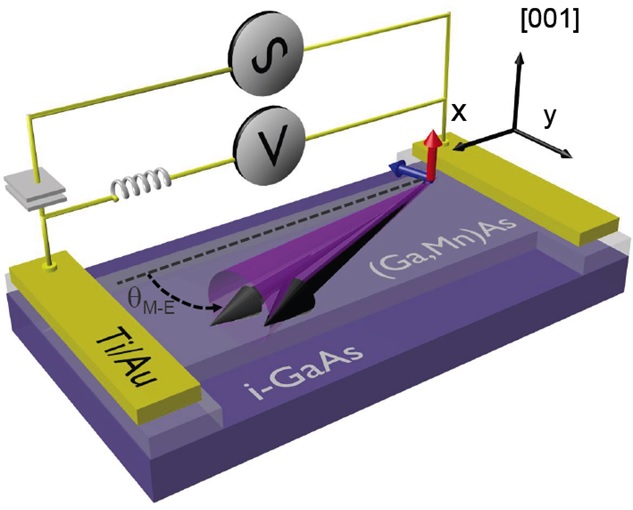Relativity shakes a magnet

Electrically shaken GaMnAs magnet (source/©: Jairo Sinova)
The research group of Professor Jairo Sinova at the Institute of Physics at Johannes Gutenberg University Mainz (JGU), in collaboration with researchers from Prague, Cambridge, and Nottingham, have predicted and discovered a new physical phenomenon that allows to manipulate the state of a magnet by electric signals. Current technologies for writing, storing, and reading information are either charge-based or spin-based.
Semiconductor flash or random access memories are prime examples among the large variety of charge-based devices. They utilize the possibility offered by semiconductors to easily electrically manipulate and detect their electronic charge states representing the “zeros” and “ones”. The downside is that weak perturbations such as impurities, temperature change, or radiation can lead to uncontrolled charge redistributions and, as a consequence, to data loss. Spin-based devices operate on an entirely distinct principle.
In some materials, like iron, electron spins generate magnetism and the position of the north and south pole of the magnet can be used to store the zeros and ones. This technology is behind memory applications ranging from kilobyte magnetic stripe cards to terabyte computer hard disks. Since they are based on spin, the devices are much more robust against charge perturbations. However, the drawback of current magnetic memories is that in order to reverse the north and south poles of the magnet, i.e., flip the zero to one or vice versa, the magnetic bit has to be coupled to an electro-magnet or to another permanent magnet. If instead one could flip the poles by an electric signal without involving another magnet, a new generation of memories can be envisaged combining the merits of both charge and spin-based devices.
In order the shake a magnet electrically without involving an electro-magnet or another permanent magnet one has to step out of the realm of classical physics and enter the relativistic quantum mechanics. Einstein’s relativity allows electrons subject to electric current to order their spins so they become magnetic. The researchers took a permanent magnet GaMnAs and by applying an electric current inside the permanent magnet they created a new internal magnetic cloud, which was able to manipulate the surrounding permanent magnet. The work has been published in the journal Nature Nanotechnology on 2 March 2014.
The observed phenomenon is closely related to the relativistic intrinsic spin Hall effect which Jörg Wunderlich, Jairo Sinova, and Tomas Jungwirth discovered in 2004 following a prediction of Sinova and co-workers in 2003. Since then it has become a text-book demonstration of how electric currents can magnetize any material. “Ten years ago we predicted and discovered how electric currents can generate pure spin-currents through the intrinsic structure of materials. Now we have shown how this effect can be reversed to manipulate magnets by the current-induced polarization.
These new phenomena are a major topic of research today since they can lead to new generation of memory devices. Besides our on-going collaborations, this research direction couples very well with on-going experimental research here in Mainz. Being part of this world-leading research and working with superb colleagues is an immense privilege and I am very excited about the future”, says Professor Jairo Sinova.
Publication:
Kurebayashi, H., Sinova, J. et al.
An antidumping spin–orbit torque originating from the Berry curvature
Nature Nanotechnology, 2 March 2014
DOI: 10.1038/nnano.2014.15
Figure:
http://www.uni-mainz.de/bilder_presse/08_physik_GaMnAs_magnet.jpg
Electrically shaken GaMnAs magnet
(source/©: Jairo Sinova)
Further information:
Professor Dr. Jairo Sinova
Institute of Physics
Johannes Gutenberg University Mainz (JGU)
D 55099 Mainz, GERMANY
phone +49 6131 39-21284
e-mail: sinova@uni-mainz.de
www.sinova-group.physik.uni-mainz.de/
http://dx.doi.org/10.1038/nnano.2014.15 – Article in NATURE NANOTECHNOLOGY ;
http://www.uni-mainz.de/presse/17107_ENG_HTML.php – press release ;
http://www.sinova-group.physik.uni-mainz.de/ – Sinova Group at the JGU Institute of Physics
Media Contact
All latest news from the category: Power and Electrical Engineering
This topic covers issues related to energy generation, conversion, transportation and consumption and how the industry is addressing the challenge of energy efficiency in general.
innovations-report provides in-depth and informative reports and articles on subjects ranging from wind energy, fuel cell technology, solar energy, geothermal energy, petroleum, gas, nuclear engineering, alternative energy and energy efficiency to fusion, hydrogen and superconductor technologies.
Newest articles

Innovative 3D printed scaffolds offer new hope for bone healing
Researchers at the Institute for Bioengineering of Catalonia have developed novel 3D printed PLA-CaP scaffolds that promote blood vessel formation, ensuring better healing and regeneration of bone tissue. Bone is…

The surprising role of gut infection in Alzheimer’s disease
ASU- and Banner Alzheimer’s Institute-led study implicates link between a common virus and the disease, which travels from the gut to the brain and may be a target for antiviral…

Molecular gardening: New enzymes discovered for protein modification pruning
How deubiquitinases USP53 and USP54 cleave long polyubiquitin chains and how the former is linked to liver disease in children. Deubiquitinases (DUBs) are enzymes used by cells to trim protein…



